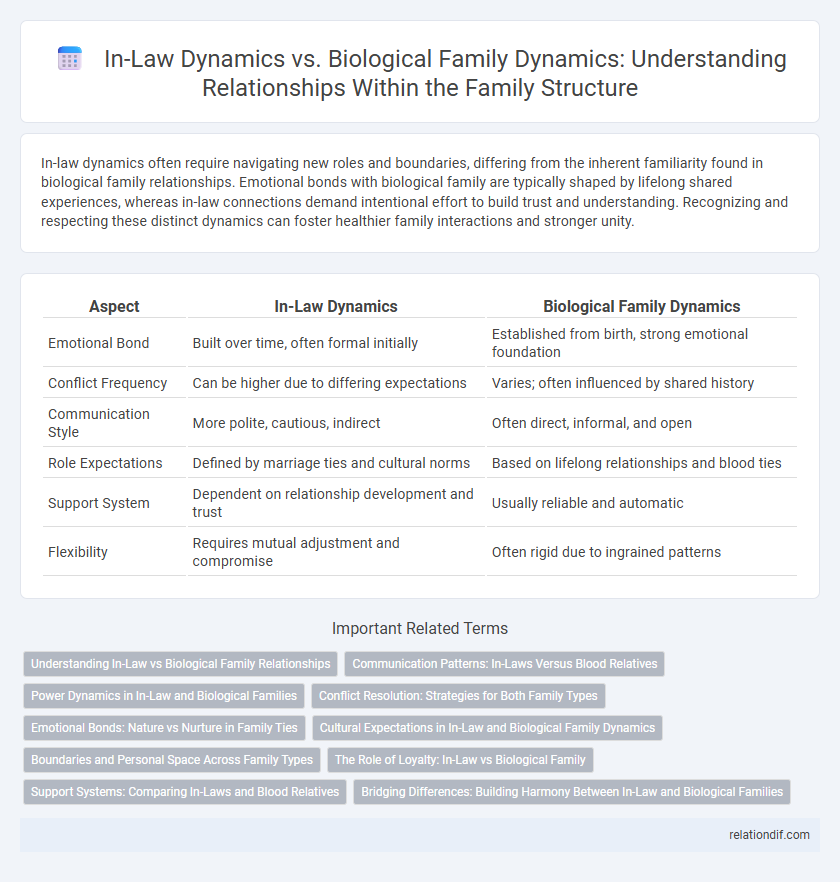In-law dynamics often require navigating new roles and boundaries, differing from the inherent familiarity found in biological family relationships. Emotional bonds with biological family are typically shaped by lifelong shared experiences, whereas in-law connections demand intentional effort to build trust and understanding. Recognizing and respecting these distinct dynamics can foster healthier family interactions and stronger unity.
Table of Comparison
| Aspect | In-Law Dynamics | Biological Family Dynamics |
|---|---|---|
| Emotional Bond | Built over time, often formal initially | Established from birth, strong emotional foundation |
| Conflict Frequency | Can be higher due to differing expectations | Varies; often influenced by shared history |
| Communication Style | More polite, cautious, indirect | Often direct, informal, and open |
| Role Expectations | Defined by marriage ties and cultural norms | Based on lifelong relationships and blood ties |
| Support System | Dependent on relationship development and trust | Usually reliable and automatic |
| Flexibility | Requires mutual adjustment and compromise | Often rigid due to ingrained patterns |
Understanding In-Law vs Biological Family Relationships
In-law relationships often involve navigating external family boundaries and developing mutual respect despite differing traditions, while biological family dynamics are typically rooted in shared history and inherent bonds. In-laws bring unique perspectives and expectations that may challenge established family patterns, requiring intentional communication and empathy for harmonious integration. Understanding these nuances fosters stronger connections by balancing respect for existing biological ties with openness to new relational roles.
Communication Patterns: In-Laws Versus Blood Relatives
In-law relationships often involve more formal and cautious communication patterns compared to the typically more open and habitual exchanges seen among biological family members. Boundaries and expectations are negotiated carefully with in-laws, while blood relatives tend to share implicit understandings and long-standing communication norms. These differences influence conflict resolution styles, emotional expression, and the development of trust within family dynamics.
Power Dynamics in In-Law and Biological Families
Power dynamics in in-law families often involve negotiations of boundaries and influence as new members integrate, contrasting with the more established roles and hierarchies typically found in biological family dynamics. In biological families, power is frequently distributed based on long-standing relationships and generational roles, whereas in-law relationships can shift as alliances and loyalties develop over time. Understanding these differences is crucial for managing conflicts and fostering healthy communication between in-laws and biological relatives.
Conflict Resolution: Strategies for Both Family Types
Conflict resolution in in-law dynamics often requires heightened communication sensitivity and boundary-setting due to differing family cultures and expectations. Biological family conflicts can benefit from historical understanding and shared experiences, enabling more empathetic negotiation and forgiveness. Utilizing active listening, empathy, and establishing clear boundaries are effective strategies for resolving disputes in both family types.
Emotional Bonds: Nature vs Nurture in Family Ties
Emotional bonds within in-law relationships often develop through shared experiences and mutual respect, emphasizing nurture over nature, unlike biological family ties where genetic connections influence inherent emotional attachment. While biological families may exhibit instinctive loyalty and deep-seated emotional responses due to shared DNA, in-law dynamics require intentional effort to build trust and affection. The interplay between inherited predispositions and cultivated relationships shapes the strength and stability of these family ties, highlighting the complex nature versus nurture balance in emotional bonding.
Cultural Expectations in In-Law and Biological Family Dynamics
Cultural expectations significantly shape the dynamics between in-laws and biological family members, often dictating roles, responsibilities, and communication styles within the family unit. In many cultures, in-laws are expected to conform to established family traditions and hierarchies, which can create tension or reinforce bonds depending on adherence to these social norms. Biological families typically experience more fluid dynamics influenced by shared history and emotional ties, while in-law relationships are frequently navigated through the lens of cultural rituals and social obligations.
Boundaries and Personal Space Across Family Types
In-law dynamics often require more explicit boundary-setting due to differing expectations and less inherent familiarity compared to biological family relationships. Personal space in in-law interactions tends to be negotiated carefully to avoid conflicts, as these relationships lack the established patterns found in biological families. Biological families typically exhibit more implicit understandings of personal space, allowing for more relaxed interactions while still navigating shared boundaries.
The Role of Loyalty: In-Law vs Biological Family
Loyalty in family dynamics often varies significantly between in-law and biological relationships, with biological family ties typically rooted in shared history and genetics, fostering a deep-seated sense of allegiance and obligation. In contrast, loyalty toward in-laws is frequently shaped by social connections, marital bonds, and mutual respect, which can require more intentional effort to maintain harmony and support. Navigating these differing forms of loyalty demands emotional intelligence and clear communication to balance commitments and uphold healthy family relationships.
Support Systems: Comparing In-Laws and Blood Relatives
Support systems within in-law relationships often hinge on negotiated boundaries and evolving trust, contrasting with the inherent history and deep-rooted emotional bonds found in biological family dynamics. In-laws may offer fresh perspectives and external insights that diversify support, while blood relatives typically provide unwavering, long-term emotional stability due to shared upbringing and genetic ties. Navigating conflicts and fostering mutual respect are crucial for strengthening support networks across both family types.
Bridging Differences: Building Harmony Between In-Law and Biological Families
Navigating in-law dynamics requires understanding distinct family cultures and communication styles to foster mutual respect and unity. Establishing clear boundaries and open dialogue cultivates trust, easing tensions that often arise from differing traditions and expectations. Prioritizing shared values and collaborative problem-solving strengthens the bond between in-law and biological families, promoting lasting harmony.
in-law dynamics vs biological family dynamics Infographic

 relationdif.com
relationdif.com